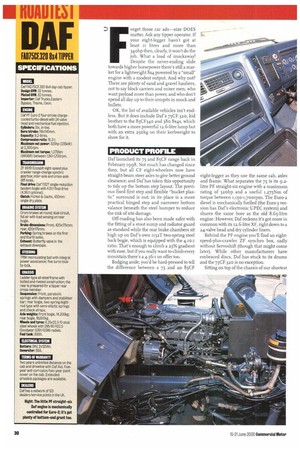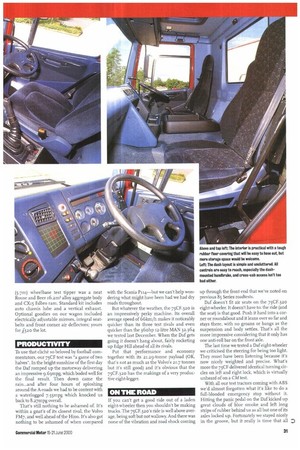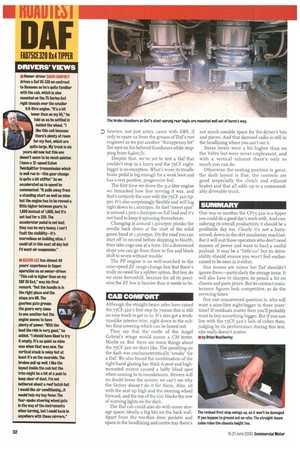D orget those car ads—size DOES
Page 32

Page 33

Page 34

If you've noticed an error in this article please click here to report it so we can fix it.
matter. Ask any tipper operator. If your eight-legger hasn't got at least it litres and more than 34ohp then, clearly, it won't do the job. What a load of muckaway! Despite the never-ending slide towards higher horsepower there's still a market for a lightweight 8x4 powered by a "small" engine with a modest output. And why not? There are plenty of sand and gravel hauliers, not to say block carriers and mixer men, who want payload more than power, and who don't spend all day up to their armpits in muck and bullets.
OK, the list of available vehicles isn't endless. But it does include Daf's 75CF.32o, kid brother to the 85CF34o and 380 8x4s, which both have a more powerful 12.6-litre lump but with an extra 250kg on their kerbweight to show for it.
PRODUCT PROFILE
Daf launched its 75 and 85CF range back in February 1998. Not much has changed since then, but all CF eight-wheelers now have straight-beam steer axles to give better ground clearance; and Daf has taken this opportunity to tidy up the bottom step layout. The previous fixed first step and flexible "bucket plastic" surround is out; in its place is a more practical hinged step and narrower bottom valance beneath the steel bumper to reduce the risk of site damage.
Off-roading has also been made safer with the fitting of a stout sump and radiator guard as standard while the rear brake chambers sit high up on Daf s own 1132T two-spring steel back bogie, which is equipped with the 4.10:1 ratio. That's enough to climb a 25% gradient with ease, but if you really want to climb every mountain there's a 4.56:1 on offer too.
Badging aside, you'd be hard-pressed to tell the difference between a 75 and an 85CF eight-legger as they use the same cab, axles and frame. What separates the 75 is its 9.2litre PF straight-six engine with a maximum rating of 320hp and a useful 1,275Nm of torque between 1,150-1,700rpm. The Euro-2 diesel is mechanically fuelled (the Euro-3 version has Daf s electronic UPEC system) and shares the same bore as the old 8.65-litre engine. However, Daf reckons it's got more in common with its 12.6-litre XF, right down to a 24-valve head and dry cylinder liners.
Behind the PF engine you'll find an eightspeed-plus-crawler ZF synchro box, sadly without Servoshift (though that might come later). While other manufacturers have embraced discs, Daf has stuck to its drums and the 75CF.320 is no exception.
Sitting on top of the chassis of our shortest (5.7m) wheelbase test tipper was a neat Rouse and Beer f 6.2 m3 alloy aggregate body and CXI5 Edbro ram. Standard kit includes auto chassis lube and a vertical exhaust. Optional goodies on our wagon included electrically adjustable mirrors, integral seatbelts and front corner air deflectors; yours for f520 the lot.
PRODUCTIVITY
To use that cliche so beloved by football commentators, our 75CF test was "a game of two halves". In the bright sunshine of the first day the Daf romped up the motorway delivering an impressive 9.63mpg, which boded well for the final result Then down came the rain...and after four hours of sploshing around the A-roads we had to be content with a waterlogged 7.55mpg which knocked us back to 8.27mpg overall.
That's still nothing to be ashamed of. It's within a gnat's of its closest rival, the Volvo FM7, and well ahead of the Hino. It's also got nothing to be ashamed of when compared with the Scania Pii4—but we can't help wondering what might have been had we had dry roads throughout.
But whatever the weather, the 75CF.32o is an impressively perky machine. Its overall average speed of 66km/h makes it noticeably quicker than its three test rivals and even quicker than the 360hp 12-litre MAN 32.364 we tested last December. When the Daf gets going it doesn't hang about, fairly rocketing up Edge Hill ahead of all its rivals.
Put that performance and economy together with its 21.29-tonne payload (OK, that's not as much as the Volvo's 21.7 tonnes but it's still good) and it's obvious that the 75CF.320 has the makings of a very productive eight-legger.
ON THE ROAD
If you can't get a good ride out of a laden eight-wheeler then you shouldn't be making trucks. The 75CF.32o's ride is well above average, being soft but not wallowy. And there was none of the vibration and road shock coming up through the front end that we've noted on previous 85 Series roadtests.
Daf doesn't fit air seats on the 75CF.32o eight-wheeler. It doesn't have to: the ride (and the seat) is that good. Push it hard into a corner or roundabout and it leans over so far and stays there, with no groans or bangs as the suspension and body settles. That's all the more impressive considering that it only has one anti-roll bar on the front axle.
The last time we tested a Daf eight-wheeler we criticised the steering for being too light. They must have been listening because it's now nicely weighted and precise. What's more the 75CF delivered identical turning circles on left and right lock, which is virtually unheard of on a CM test.
With all our test tractors coming with ABS we'd almost forgotten what it's like to do a full-blooded emergency stop without it. Hitting the panic pedal on the Daf kicked up great clouds of blue smoke and left long strips of rubber behind us as all but one of its axles locked up. Fortunately we stayed nicely in the groove, but it really is time that all p heavies, not just arncs, carne with ABS, if only to spare us from the groans of Daf's test engineer as we put another "thruppenny bit" flat spot on his beloved Goodyears while stopping from 64km/h.
Despite that, we've yet to test a Daf that couldn't stop in a hurry and the 75CF eightlegger is no exception. What's more its treadle brake pedal is big enough for a work boot and has a very positive, progressive feel.
The first time we drove the 9.2-litre engine we remarked how free revving it was, and that's certainly the case with the 75CF.32o tipper. It's also surprisingly flexible and will lug right down to L000rpm. Its fuel "sweet spot" is around 1,5oo-1,600rpm on full load and it's not hard to keep it spinning thereabouts.
Changing at around 1,900rpm plonks the needle back down at the start of the solid green band at i,3oorpm. On the road you can start off in second before skipping to fourth, then take cogs one at a time. On a downward slope you can go from three to five and block shift to seven without trouble.
The PF engine is so well-matched to the nine-speed 2F range-change box that there's really no need for a splitter option. But boy, do we miss Servoshift, because for all its precision the 2F box is heavier than it needs to be.
CAB COMFORT
Although the straight-beam axles have raised the 75CF.32o's first step by 7omm this is still an easy truck to get in to. It's also got a workmanlike interior trim, right down to the rubber floor covering which can be hosed out.
They say that the rustle of the Angel Gabriel's wings would annoy a CM tester. Maybe so. But there are some things about the 75CF.32o we don't like. The panelling on the dash was uncharacteristically "creaky" for a Dal We also found the combination of the right-hand glazing bar, thick A-post and highmounted mirror caused a hefty blind spot when coming in to roundabouts. Drivers will no doubt lower the mirror: we can't see why the factory doesn't do it for them. Also, sit with the seat up high and the steering wheel forward, and the top of the rim blocks the row of warning lights on the dash.
The Daf cab could also do with more storage space; ideally a big bin on the back wall. Apart from the too-thin door pockets and space in the headlining and centre tray there's not much useable space for the driver's bits and pieces. And that damned radio is still in the headlining where you can't see it.
Noise levels were a bit higher than on the Volvo but were never unpleasant, and with a vertical exhaust there's only so much you can do.
Otherwise the seating position is great, the dash layout is fine, the controls are good (especially the clutch and exhaust brake) and that all adds up to a commendably driveable truck.
SUMMARY
One way or another the CF75.32o is a tipper you could do a good day's work with. And considering its overall productivity it should be a profitable day too. Clearly it's not a hairyarmed, down-in-the-dirt muckaway machine. But it will suit those operators who don't need masses of power and want to haul a useful payload. It may be a "little'un" but its driveability should ensure you won't feel embarrassed to be seen in it either.
Our moans are minor but Dal shouldn't ignore them—particularly the storage issue. It will also have to sharpen its pencil a bit on chassis and parts prices. But its contract maintenance figures look competitive, as do the servicing times.
Our one unanswered question is, who will want a nine-litre eight-legger in three years' time? If residuals matter then you'll probably want to buy something bigger. But if you can live with the 75CF.32o's lack of cubes then, judging by its performance during this test, size really doesn't matter.
• by Brian Weatherley












































































































